SATURDAY, SEPTEMBER 23
Puna is great for hats. Most common are choclate soup plates baring one of those round buns that have swollen above the baking tin. I admire a pink bowler with silk ribbon edging the underside of the brim. Another favourite is a mini black bowler with a tassel warn at a jaunty angle by a plump lady in her fifties. She is dressed in black. White petticoats fluff up her skirt. A shy thin woman wears a yellow hat of plastic straw sprinkled with glitter. A teenage boy favours a red wool cloche. Then there is the man in the grey fedora who, hands in pockets, poses as an Italian Mafioso. Backpackers favour a design on white wool, the top drawn to a point, a tuft on the crest and earflaps. An elderly grey Stetson talks to two junior baseball caps. Strangest is a wide brim golden pentagon; blue lines mark the segments. Can it be a hat or is it a lampshade out for a walk? The owner is a severe schoolmistressy woman near retirement.
septuagenarian odyssies - US/Mexican border to Tierra del Fuego, Tierra del Fuego to New York, long ride round India
Saturday, September 23, 2006
PUNA
FRIDAY, SEPTEMBER 22
Sun sets as I ride the final kilometres into Puna. The drop in temperature is instant. I could weep icicles. A fiesta grips the city centre. The road to my chosen hotel is blocked. A cop suggests the Gran Puna Inn. A young concierge runs to open the locked glass doors and laughs as he slides on the polished floor. $25 is beyond my budget. The manager settles for $20 to include a buffet breakfast. He and the concierge lift the Honda over the curb and into the lobby. My room is on the fourth floor, no elevator. The stairs are steep. I fear for my unmedicated heart. The concierge offers me coca leaves infused in hot water.
The room is spacious. So is the bathroom. The shower runs hot. The bath towels are thick and vast. The bath mat is a miraculous extra as are an electric radiator and Cable TV. I hope for the Ryder Cup. No luck.
Sun sets as I ride the final kilometres into Puna. The drop in temperature is instant. I could weep icicles. A fiesta grips the city centre. The road to my chosen hotel is blocked. A cop suggests the Gran Puna Inn. A young concierge runs to open the locked glass doors and laughs as he slides on the polished floor. $25 is beyond my budget. The manager settles for $20 to include a buffet breakfast. He and the concierge lift the Honda over the curb and into the lobby. My room is on the fourth floor, no elevator. The stairs are steep. I fear for my unmedicated heart. The concierge offers me coca leaves infused in hot water.
The room is spacious. So is the bathroom. The shower runs hot. The bath towels are thick and vast. The bath mat is a miraculous extra as are an electric radiator and Cable TV. I hope for the Ryder Cup. No luck.
ALTIPLANO
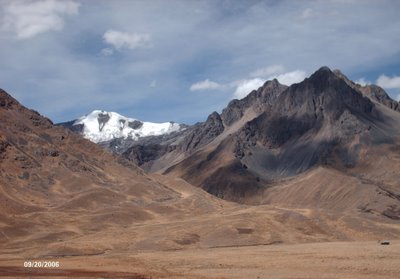
north of the cusco-puna road
FIDAY, SEPTEMBER 22
The road is straight, the surface excellent. The Honda cruises at 80 KPH. I inhale fresh chill air and revel in the intense beauty of the altiplano. The mountains are dark rock. A wedge of snow appears. The herds are mostly alpacca. I can differentiate them from lamas. I enquired of a herdswoman. The alpacca are shorter and have bulkier coats. The herdswoman’s home was an adobe hovel. That is the truth of the alto plano: poor soil, nights of vicious cold. Many hovels stand empty. The people have fled certain poverty. The squatter towns of Puna, Cusco or Lima tempt with the possibility of a marginally better life.
LIVESTOCK
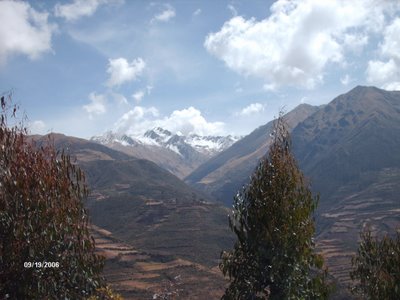
last valley before cusco
FRIDAY, SEPTEMBER 22
In Cusco I am income, two legged livestock. I will learn nothing of Peru. On arrival at the Hostal Marani the Dutch manager asked me to tell her in the morning whether I wished to stay a further day. I tell her this morning. She tells me the hotel is fully booked. I have my excuse. Thirty minutes and I am packed and on the road to Puna.
Road and rail share a wide river valley. At first there are fields. The road climbs and I am back on the altiplano. The clarity of light is extraordinary, the deep blue of the sky and feel of unlimited space. I stop at a plush roadhouse to use the lavatory. A Belgium coach party enjoys a buffet lunch. The tour guide travelled solo for three years. He found passage on a US registered yacht from Panama to Cartagena. He is due in Patagonia next month. He will email me his schedule. His tour group gathers round the Honda. We shake hands. They wish me happy travelling.
ART

across the fells
THURSDAY, SEPTEMBER 21
A short ride takes me up to Cusco. The cathedral is superb. A canvas is being relined. Teaching restoration is a department of the School Of Belles Artes. Study is free – unlike Ecuador. Peru has endless art in need of restoration and many trained restorers. Funds to pay the restorers are in short supply. I talk with the head of restoration. We talk of the artistic explosion that accompanied the conquest. Indigenous artists were given the tools and were freed from constraint. They leapt from lugging boulders to creating the Rosario chapel. Their work will be marvelled at as long as this planet survives. Then came the Inquisition. Thinking outside the box was again prohibited. Spain and Latin America atrophied.
INCA

family home
THURSDAY, SEPTEMBER 21
Nasca was a break. Now I am back travelling. I have failed to get a handle on Peru. I am disturbed by the contrast between extreme poverty and dirt and that Peru is a tourist Mecca. Inca worship is in fashion. I am out of fashion. I see a thousand years without change, without discovery. I look at Inca stonework and wonder how many slaves were killed and maimed on the construction site. To shift a 30ton boulder up a mountain rather than use cut blocks seems to me a failure. I take on trust an expert’s opinion as to the era of a ceramic or scrap of woven cloth; my interest is minimal.
ANDES
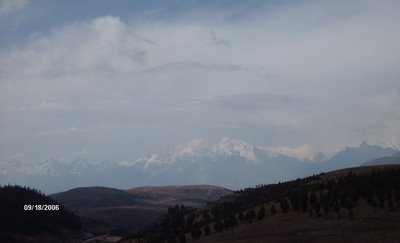
WEDNESDAY, SEPTEMBER 20
The alto plano ends. The road winds and backtracks down a steep mountain face. The drop is dizzying. I quake when forced by a truck to the outside of a curve. At bottom the road follows a river gorge. The gorge funnels the wind. Tiny patches of tilled soil edge the water - fields would be a misnomer. A woman shares the shade of a fruit tree with two sheep. She returns my wave. The gorge narrows to nothing and the road climbs. The Honda is valiant. Up we go, up and up. We hit the top and wow! The majestic sweep of the high Andes is spread across the horizon. The view of snow capped peaks is magnificent. Surprise is total. The road drops again and follows another river. 100 Ks to Cusco… Exhausted, I pull into a roadside inn. They have a room with a bath ($7). They also have flies. The flies bite. Each bite raises a purple bruise with a minute blood-drop dead centre. The bites itch. The beef at dinner is a further candidate for the Peruvian arms industry. I am out of cardiac medication. I can’t sleep. I lie awake and itch and obsess over the state of my heart.
ANGER

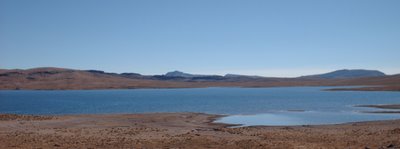
alpacca
tarn
WEDNESDAY, SEPTEMBER 20
The road flows over high fells. I can see for miles. Way in the distance a lone truck creeps over a crest. A tarn to the left of the road reflects the deep blue of the sky. Small groups of vicuna graze the tufted grass. A couple of shaggy ponies watch from a rise. Snow covers a soft ridge between black rock peaks. A herdswoman chivvies a flock of alpacca. Riding here is easy. Free to muse, I dwell on yesterday’s conversation with the engineer. I wrote yesterday’s blog in anger. Anger has been inescapable on much of this journey. I have been riding through the United States’ back yard, a back yard the US has been tilling for the past two hundred years. Successive Administrations have suborned Governments supported the vilest of dictators, trained military for whom murder and torture are the norm. Bush supports torture as necessary. Where does US society stand? Behind their President? Behind that great TV hero of 24 Hours, an all-American Hero brave enough to torture prisoners? This is the good guy. No wonder the US military are confused. No wonder that Latin Americans are sickened by the US’s claim to hold the moral high ground. I long to see Bush and Romsfeld and Cheney strapped to waterboards. Blair I would dunk in a witch’s chair.
Friday, September 22, 2006
TORTURE
An electrical engineer sits at the next table at the Estancia restaurant in Pequia. He has three sons. The eldest is also an engineer; the second is an architect; the third is studying computer science at university. My companion is a great reader and a student of current affairs. He asks my nationality and says, “Your Tony Blair is a tremendous liar.”
“Yes,” I say.
“And now Bush makes torture legal. How do you feel?”
Few people I meet on this journey differentiate between the US and Britain. Blair has implicated us totally. How do I feel? I feel deeply sullied.
My daughter, Anya, complains that I accuse all Americans of torture. I accuse all Americans of complicity in torture. We Britains are accomplices. This is Blair’s doing. He has made us accomplices to so much evil and to so much stupidity. Yes, I feel sullied, but also enraged that one man should take my nation down such a filth-strewn road.
“Yes,” I say.
“And now Bush makes torture legal. How do you feel?”
Few people I meet on this journey differentiate between the US and Britain. Blair has implicated us totally. How do I feel? I feel deeply sullied.
My daughter, Anya, complains that I accuse all Americans of torture. I accuse all Americans of complicity in torture. We Britains are accomplices. This is Blair’s doing. He has made us accomplices to so much evil and to so much stupidity. Yes, I feel sullied, but also enraged that one man should take my nation down such a filth-strewn road.
ARMS INDUSTRY
Pequia is 160 Ks from Nasca. Mid afternoon and I am exhausted. I ride up a dirt street in search of a hotel. This is market day or all days are market days. Small dark people bundled in sweaters and wool jackets overflow the sidewalk. Men and women wear brown felt hats. Doorways overflow with used clothes. The one hotel is on a street being laid with drains. The sidewalk is too narrow for the Honda and a meter above the digging. I park the Honda indoors at the hotel owner’s house. She directs me to a restaurant. The Peruvian arms industry could build tanks out of the beef. I chomp and read the newspaper. Pillaging of the military and police pension fund occupies the first four pages.
VICUNAS
GLOBAL WARMING
The road from Nasca twists up through dry mountains, a climb of over 3000 meters. I find a neat clean café at the top. Bowls of brilliant wild flowers liven the counter. The owner is in his sixties. He has lived here all his life. In his youth the hills were green. Farmers kept dairy cattle. Little rain has fallen over the past twenty years. The cattle have gone. Global warming…
CUSCO

I have seen innumerable photographs of the Nasca lines. I have read the theories and the fictions. I have wondered at the obsessivness of archaeologists. Tourists view the lines from the air. $50 is the price. Few locals can spare $50. None of the staff at the Hostal have seen the lines. I cooked for the staff and raced up and down sand dunes with Juan Carlos, Victor and Carmen. They made me welcome, treated me as a friend, made me feel at home. I had a ball – no need for lines. I thank them and I thank the people of Nasca - what joy to wander the streets at night without fear of assault. Now I am in Cusco. My guidebook warns of frequent rapes and strangle mugging and mugging by cab drivers and of pickpockets and con artists. I am staying at a Dutch owned Hostal, the Marani on Carmen Alto. Profits go to the Hope Foundation, a worthy cause. The Honda rests in an ample and pleasant patio. The street is narrow and cobbled. All streets are narrow and cobbled. Most are steep. Many have steps. Every doorway opens to a restaurant, a tour seller or an internet connection. Prices are high. I see foreigners everywhere. Down on the Plaza de Armas The Cross Keys is a Brit-owned pub. The Rat Hole is a biker’s bar, the owner from Arizona. Hustlers abound. This is what Antigua, Guatemala, has become.
Monday, September 18, 2006
COCK FIGHTING

SUNDAY, SEPTEMBER 17
We are at the cock fights. The small sand arena is ringed by banks of concrete benching. The benches are full: grandads, mums and dads, teens, babes scarcely out of arms. The faces fascinate me - and the postures. They are so familiar: the bad tempered minor official; the four men over-drinking beer from the bottle; the teenager girl, a novice smoker, attempting to appear sophisticated as she puffs inexpertly on a cigarette.
An overweight mother makes a second dash to the cafeteria. First she gives her five-year-old son a good shaking and plonks him on the tier behind us: “Move from there and I’ll murder you.”
The faces may be darker, no other difference from any European crowd.
I recall the baseball game in Dallas. There I felt myself on unknown territory. I discovered no clues by which to assess what or who people were. Uniformity was the rule, faces equally groomed, equally bland, jeans or khaki drill obligatory.
PRAWNS AND CRAB
SUNDAY, SEPTEMBER 17
I have been cooking. I pretend that I am cooking for the staff at the Hostal Via Morburg. I am cooking for myself. Friday I bought live crab in the market and prepared a sauce: olive oil, onion, tomato, celery, garlic, red peppers, root ginger, chilli, fresh coriander. Yesterday I cooked prawns. Today I am using the remains of the prawns to flavour a pasta sauce. Two young sophisticates from the capital arrived late last night: Victor is first cousin to Juan Carlos. His novia, Carmen, is a dancer in a modern dance group. Sunday lunch of prawn pasta makes up for the lack of water (the pump is electric). Full-bellied, we commit ourselves to Juan Carlos and his buggy. We race down a dry river. Carmen is dismissive of the parched countryside. Then we hit the dunes. The dunes transform Carmen into a fanatic. Drop her three-quarters of the way up a dune with a three hundred meter slide ahead - disastisfied, she clambers the extra hundred meters to the summit. Jed would do the same. I have watched him. Every meter of altitude counts, every extra degree of gradient.
While the kids play, I sit on a dune crest and watch the breeze obliterate our footsteps. The view is superb and extraordinary. The temperature is perfect. No flies, no mosquitoes…Nasca deserves more than the standard one night stop on the tourist trail.
I have been cooking. I pretend that I am cooking for the staff at the Hostal Via Morburg. I am cooking for myself. Friday I bought live crab in the market and prepared a sauce: olive oil, onion, tomato, celery, garlic, red peppers, root ginger, chilli, fresh coriander. Yesterday I cooked prawns. Today I am using the remains of the prawns to flavour a pasta sauce. Two young sophisticates from the capital arrived late last night: Victor is first cousin to Juan Carlos. His novia, Carmen, is a dancer in a modern dance group. Sunday lunch of prawn pasta makes up for the lack of water (the pump is electric). Full-bellied, we commit ourselves to Juan Carlos and his buggy. We race down a dry river. Carmen is dismissive of the parched countryside. Then we hit the dunes. The dunes transform Carmen into a fanatic. Drop her three-quarters of the way up a dune with a three hundred meter slide ahead - disastisfied, she clambers the extra hundred meters to the summit. Jed would do the same. I have watched him. Every meter of altitude counts, every extra degree of gradient.
While the kids play, I sit on a dune crest and watch the breeze obliterate our footsteps. The view is superb and extraordinary. The temperature is perfect. No flies, no mosquitoes…Nasca deserves more than the standard one night stop on the tourist trail.
POWER CUT
 school fete
school feteSUNDAY, SEPTEMBER 17
Building relationships is intrinsic to travel. Yesterday morning I attended the school fete. I had intended flying over the Nasca lines this morning, finishing the Blog and leaving early Monday morning for Cusco. My plans are frustrated by an electricity cut that will continue until late afternoon. The ATM machines are down. I have no money.
TOBY

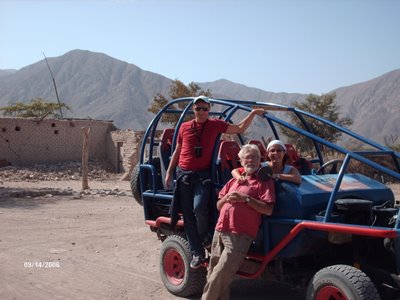
barabara doing well
honeymooners with pet toad
SATURDAY, SEPTEMBER 16
The female staff at the Hostal Via Morburg describe Juan Carlos as a Toby. A Toby is a good-looking young man, amiable, lots of charm and perhaps a little too easy. I will remember Juan Carlos with fondness as a merely moderately dangerous maniac. He speeds down desert tracks at 100 KPH in an oversize blue dune buggy. He attacks dunes with the buggy. Most times he reaches the top. For serious sport, he rides a board down the dunes. These are not dunes as normal people imagine dunes. Juan Carlos’ favourite is 1,700 metres high. I need to put that in writing less readers believe they are reading a typo: one-thousand-seven-hundred meters. This is a dune taller than the highest mountain in Great Britain. Juan Carlos rides down this dune on a one-meter-twenty board. The sand is soft. My youngest son, Jed, rides down non-sand mountains on a board with wheels. He and Juan Carlos are soul brothers - or suffer from a similar mental illness. I was out with Juan Carlos early this morning. He had an Italian couple as passengers, Barbara and Eduardo, honeymooners. Both speak good English. They are novices at sandboarding. They tried out on a small dune, the equivalent of a Blue Run. They had a ball. So did I – though I didn’t board. The desert is spectacular and being driven by Juan Carlos has the adrenaline flowing. Anyone visiting Nascar can find him through the manageress at the Hostal. I don’t know what he charges but a ride in his beach buggy must be better value than $50 to lose your breakfast in a small plane circling over lines in the dust.
Boarding a 1,700 meter dune is a once in life time experience.
Subscribe to:
Comments (Atom)
